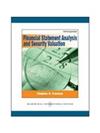This book describes valuation as an exercise in financial statement analysis. Students learn to view a firm through its financial statements and to carry out the appropriate financial statement analysis to value the firm's debt and equity. The book takes an activist approach to investing, showing how the analyst challenges the current market price of a share by analyzing the fundamentals. With a careful assessment of accounting quality, accounting comes to life as it is integrated with the modern theory of finance to develop practical analysis and valuation tools for active investing.
Key features
1.Negotiating with Mr. Market: This edition emphasizes the role of financial statement analysis in "negotiating with Mr. Market" over the price to pay for securities (to use the words of Benjamin Graham). Students will be able to understand how earnings forecasts relate to value, reverse engineer the market price to understand the forecast that Mr. Market is making, and then challenge that forecast with sound financial statement analysis.
2.Applied Analysis to Evaluating Underpricing: With the bubble valuations of the 1990s as a backdrop, earlier editions emphasized the danger of buying overpriced shares. With multiples falling below historical benchmarks during the credit crisis of the fall of 2008, this edition applies the same analysis to evaluating underpricing.
3.Comprehensive End-of-Chapter Material: Exercises apply methods covered in the chapter and are divided into Drill Exercises and Applications. Drill Exercises are simple and straightforward, and serve to ease the student into the material, while Applications help students to apply a concept theyre learning to real business practice. Other EOC material includes concept question that reinforce the thinking in the chapter and mini-cases which are designed for classroom discussion. These exercises use real-world companies to make different points in different parts of the book.
4.Module sections of the text: Each text part is a distinct module, allowing the parts to be taught out of order without inconveniencing the instructor.
5.Pedagogical features: Pedagogical features include chapter-opening flow charts, the Analyst's Checklist, and the Analyst's Toolkit. The Web Connection box at the end of each chapter directs students to features on the web page for that chapter, including accounting material. Select end-of-chapter exercises incorporate the Building Your Own Analysis valuation tool on the website.
作者簡介
Stephen Penman
現職:Stephen Penman is the George O. May Professor and the Morgan Stanley Research Scholar in the Graduate School of Business, Columbia University. He also serves as co-director of Columbia's Center for Excellence in Accounting and Security Analysis.











